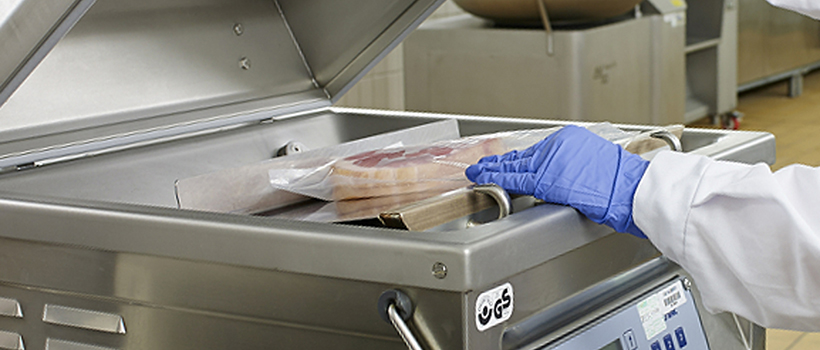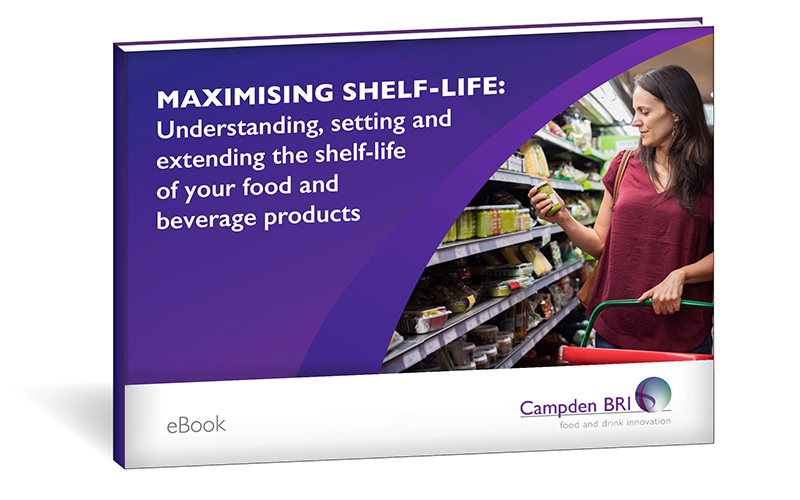
Modified atmosphere packaging - 'The carbon dioxide effect'
11 February 2023 | Lynneric Potter, Food Packaging Technical Lead
Modified atmosphere packaging (MAP) is used as a means of preservation and is well known in the food industry as a method to extend the shelf-life of a range of different food products. It relates to the removal and subsequent replacement of atmospheric air with alternative gases that are optimal to the product, in order to provide the longest shelf-life while maintaining quality and safety. Changing the atmosphere in the headspace of a package can reduce biochemical changes, retard microbial growth and maintain organoleptic qualities whilst reducing the need for additives.
Download the complete Maximising Shelf-life eBook, for free, to unlock the tools for measuring and maximising the shelf-life of your food and drink products whilst ensuring their safety and quality.

Modified atmospheres: Methods and history
A modified atmosphere can be produced in a number of ways:
- passive modification is more commonly associated with fruits and vegetables by matching the respiration rate with the permeability of the film to create a favourable atmosphere
- gas packing can be used in combination with a vacuum (compensated vacuum) or by just gas flushing
- compensated vacuum firstly applies a vacuum to the pack to draw out the air and then the desired gas mixture is flushed into the pack.
Gas packing relies on a continuous stream of gas being injected into the pack to replace the air. The disadvantage of gas packing is that the residual oxygen levels can be higher, which make it an unsuitable method for oxygen sensitive products. Compensated vacuum can be slower as it is a two-stage process, but the residual oxygen levels are usually lower.
The first recorded scientific study with modified atmospheres was conducted in 1821 by Jacques Etienne Berard who found that the ripening of fruits could be delayed by removing oxygen. Advances with controlled atmosphere storage continued, initially with a number of studies on fresh fruit contained within a gas-tight building relying on the respiration of the produce to generate a passive atmosphere.
The method was developed further in 1929 with controlled atmosphere storage. This refers to bulk storage where the atmosphere is controlled and monitored. It can be used during the transportation of fruit and vegetables by sea or for storing produce so that it is available throughout the year.
Following Berard’s work, studies continued, mainly with meat and fish. These focused predominantly on the effects of carbon dioxide with results showing a dramatic increase in shelf-life compared to air. MAP made its debut in the retail industry in the 1970s, initially with meats and fish, and has rapidly grown as a market to cover the majority of food groups.
The interaction between the gas and the food is critical and needs to be understood to select the correct gas mixture. Commonly a mixture of one, two or three gases, usually nitrogen, carbon dioxide or oxygen are used. The gases used play an integral role in the finished pack.
The effect of oxygen
Oxygen is usually removed from the pack, particularly with dried foods, ready cooked products and those with high fat contents to reduce oxidation and inhibit aerobic microbial growth. However, with some products the presence of oxygen can be beneficial. With red meat, oxygen helps develop the red colour and is used in high concentrations of 70-80% within the pack. In the presence of high levels of oxygen, purple myoglobin (in the meat) may be oxygenated to the red pigment oxymyoglobin or in low levels oxidised to metmyoglobin, giving the undesirable brown colour.
Fresh produce requires oxygen to continue respiring. It also produces carbon dioxide as a by-product. During the modified atmosphere packaging of fresh produce, the level of oxygen is usually reduced from that of atmospheric air (21%) to approximately 5% depending on the product. Reducing the oxygen slows the respiration of the produce, which can be high, as the cells try to repair themselves following the preparation processes of washing and cutting. This delays fermentation which can occur as the atmosphere becomes anaerobic.
Oxygen is often included with white fish as it can have a bleaching effect on the fish and reduces drip.
The role of nitrogen
Nitrogen is an inert gas and is often used to displace oxygen, particularly with products which are prone to oxidation. These products are often packed in 100% nitrogen. Nitrogen is also used as a filler gas to prevent pack collapse and offers some cushioning to the product.
The role of carbon dioxide
Carbon dioxide is normally included as an antimicrobial agent. A minimum of 20% CO2 is often suggested to have an effect, but there is little scientific data to back this. Carbon dioxide is often used in combination with nitrogen to form an anaerobic environment to inhibit aerobic microorganisms.
Raw and cooked meats, fish, ready meals, combination products and bakery goods will all commonly be packed with a proportion of carbon dioxide. Carbon dioxide is more commonly used at levels between 25-40% apart from in bakery goods and some cheeses where it can be used up to 100%.
Bakery goods can be packed in high levels of carbon dioxide to increase the mould-free shelf-life. Studies have shown that higher concentrations of carbon dioxide can increase the mould free shelf-life (product specific) days to weeks and months (Seiler, 1998). However, modified atmosphere packaging will not prevent the inevitable staling of bakery goods.
Carbon dioxide is highly soluble in moisture and fats. Solubility of carbon dioxide in the water phase of the product produces carbonic acid which can increase the acidity of the product resulting in a small drop in pH. Studies have shown that intrinsic and extrinsic factors influence the solubility of carbon dioxide. These may include pH, water activity, fat type and content, gas to product ratio and temperature. The solubility of carbon dioxide increases as the temperature decreases, similarly the antimicrobial activity of carbon dioxide is higher at lower temperatures (Mullan and McDowell, 2003). The change in pH may be beneficial with some products, but not all if it causes an undesirable taint.
The effect of carbon dioxide on microbes
The concentration of dissolved carbon dioxide in the water phase of food helps to inhibit some microorganisms. Gram-negative microorganisms, such as Psuedomonas, are more sensitive to carbon dioxide compared to Gram-positive. For example, the growth of Lactic acid bacteria can be stimulated by the presence of CO2 (Mullan and McDowell, 2003).
Due to solubility, high levels of carbon dioxide can cause pack collapse; nitrogen is often included to prevent this. High levels of carbon dioxide can also cause damage to plant and muscle tissues, discoloration and excessive drip.
Gas to product ratio
One aspect of MAP, which is often overlooked, is the gas to product ratio. This can often be confused with the composition of gas rather than the volume of gas added to the pack. As it is absorbed into the product, it is particularly important with carbon dioxide to get enough gas into the pack for it to have an effect. Depending on the product, it is normally recommended that a 2:1 gas to product ratio is used. However, this can result in a large seemingly empty headspace and manufacturers can be criticised for using too much material.
Plastics challenge
Modified atmosphere packaging will continue to be used as a means of preservation within the food industry. For ‘clean’ products which require a longer shelf-life, modified atmosphere is an ideal solution, however concern over the excessive use of plastics is something we need to consider for the future.
The food industry has faced significant criticism for its use of plastics and this is driving the development of alternative materials. Although there are many options to explore, there are specific food groups where this will be more technically challenging. Products packed in a modified atmosphere require the materials to have specific barrier properties and maintain seal integrity for the duration of the shelf-life of the product or the modified atmosphere will be lost. This not only relates to chilled foods but many ambient products. Many snack products such as crisps, which have been targeted by anti-plastic groups, rely on nitrogen flushing to provide a longer shelf-life and maintain the quality of the snack, slowing rancidity which can result in off-flavours. If the food industry is going to continue to supply and develop the vast range of products consumers are currently used to, then new materials must provide the same properties to ensure the quality and safety of the product is maintained.

About Lynneric Potter
Lynneric has worked at Campden BRI since 1999, and has spent the majority of this time specialising in all things packaging, including supporting members and clients, managing contract projects, and conducting research.
How can we help you?
If you’d like to find out more about modified atmosphere packaging, contact our support team to find out how we can help.
Maximising Shelf-life eBook
For more on measuring, setting and extending food and drink product shelf-life, download our ‘Maximising Shelf-life’ eBook today.







